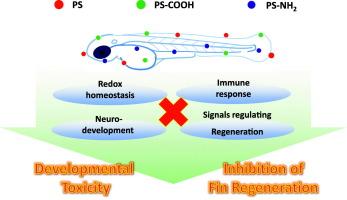功能化聚苯乙烯微塑料的发育毒性及其对斑马鱼鳍再生的抑制作用。
IF 4.3
3区 环境科学与生态学
Q2 BIOCHEMISTRY & MOLECULAR BIOLOGY
Comparative Biochemistry and Physiology C-toxicology & Pharmacology
Pub Date : 2025-09-19
DOI:10.1016/j.cbpc.2025.110358
引用次数: 0
摘要
微塑料对水生生物群的有害影响已被广泛记载。然而,表面功能化对微塑料毒理学特征的影响,特别是对鱼类的影响,需要进一步研究。在本研究中,研究了聚苯乙烯微塑料(直径50-100 nm),无论是非官能团还是羧基(-COOH)或氨基(-NH2)官能团,对斑马鱼的影响。暴露于所有三种类型的微塑料(0.1、1和10 mg/L)会导致斑马鱼在生命早期出现发育毒性。这包括死亡率增加,幼虫体长缩短,心率下降,游泳能力受损,以及氧化还原稳态,神经系统发育和免疫反应的破坏。此外,所有类型的微塑料(1 mg/L)在形态和功能上都抑制了斑马鱼尾鳍切除后的再生能力。这种抑制可能是由于免疫反应的改变、活性氧的过量产生以及调节鳍再生的信号网络的中断。在所测试的微塑料中,氨基修饰颗粒普遍表现出更大的发育毒性和更强的鳍再生抑制作用。我们的研究结果证实,微塑料的功能化在它们与生物系统的相互作用中起着至关重要的作用,并强调了功能化的潜在影响,无论是故意的还是自然风化过程的结果。本文章由计算机程序翻译,如有差异,请以英文原文为准。

Developmental toxicity of functionalized polystyrene microplastics and their inhibitory effects on fin regeneration in zebrafish
The hazardous effects of microplastics on aquatic biota have been extensively documented. However, the impact of surface functionalization on the toxicological profiles of microplastics, particularly in fish, requires further investigation. In the present study, the effects of polystyrene microplastics (50–100 nm in diameter), either non-functionalized or functionalized with carboxyl (-COOH) or amino (−NH2) groups, on zebrafish were explored. Exposure to all three types of microplastics (0.1, 1, and 10 mg/L) resulted in developmental toxicity in zebrafish at early life stages. This included increased mortality, reduced larval body length, decreased heart rate, impaired swimming ability, as well as disruptions in redox homeostasis, nervous system development, and immune responses. Moreover, all types of microplastics (1 mg/L) inhibited the regenerative capacity of larval zebrafish after caudal fin amputation, both morphologically and functionally. This inhibition was likely due to alterations in immune response, excessive production of reactive oxygen species, and disruptions in the signaling networks that regulate fin regeneration. Among the tested microplastics, amino-modified particles generally exhibited greater developmental toxicity and stronger inhibitory effects on fin regeneration. Our findings confirm that the functionalization of microplastics plays a crucial role in their interactions with biological systems and highlight concerns regarding the potential effects of functionalization, whether intentional or resulting from natural weathering processes.
求助全文
通过发布文献求助,成功后即可免费获取论文全文。
去求助
来源期刊
CiteScore
7.50
自引率
5.10%
发文量
206
审稿时长
30 days
期刊介绍:
Part C: Toxicology and Pharmacology. This journal is concerned with chemical and drug action at different levels of organization, biotransformation of xenobiotics, mechanisms of toxicity, including reactive oxygen species and carcinogenesis, endocrine disruptors, natural products chemistry, and signal transduction with a molecular approach to these fields.

 求助内容:
求助内容: 应助结果提醒方式:
应助结果提醒方式:


